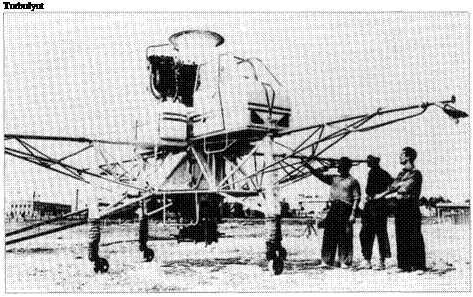Rafaelyants Turbolyot

Purpose: To evaluate a wingless jet VTOL aircraft.
Design Bureau: Aram Nazarovich Rafaelyants, chief engineer of GVF (civil air fleet) repair and modification shops at Bykovo.
Rafaelyants was working at Bykovo, on the Volga, in 1929-59. He had previously produced two lightplanes, flying his RAF-2 to Berlin in 1927. In 1941 his RAF-1 Ibis transport nearly went into production. He worked on many aircraft, and after 1945 handled projects concerned with jet engines and their testing. The Rolls-Royce Thrust Measuring Rig (‘Flying Bedstead’) of 1953 inspired him to produce the Turbolyot. This was flown tethered to a gantry in early 1957, and was publicly demonstrated in free flight in October of that year. Nearly all the flying was done by helicopter test pilot Yu A Garnayev. Because of its historical interest, the Turbolyot is today stored in the WS museum at Monino, although it was not a WS aircraft but a civilian flying test rig.
The engine selected was the Lyul’ka AL-9G, a single-shaft turbojet rated at 6,500kg (14,330 Ib). This was mounted vertically in the centre of a cruciform framework of welded steel tube. The engine had special bearings
and lubrication, and was fitted with a high – capacity bleed collector ring. On each side was a fuel tank, with fuel drawn equally from both. In front was the enclosed pilot cab, with a door on the right. The bleed system served four pipes, one to each extremity of the vehicle, where downward – and upward-pointing nozzles were provided with a modulating valve under the management of the pilot’s control column. The same system also oper
ated rods and levers governing a two-axis tilting deflector ring under the engine nozzle. Each of the four main structural girders was provided with a long-stroke vertical landing leg with a castoring wheel.
This device never crashed, and provided a solid background of data for the Yak-36 and subsequent jet-lift aircraft.










